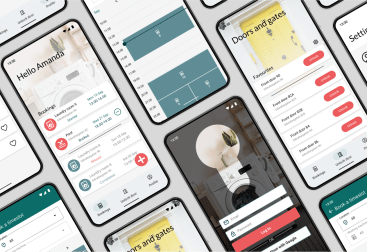By Amanda Djäknegren & Frida Grothérus
Over 5% of the world’s population has reduced hearing which requires a compensating measure¹. Bone conduction technology is a way to bypass the eardrum by producing vibrations that are transported through the bone directly to the inner ear. However, research suggests up to 56% of all assistive technologies are rejected². So far, the innovation of bone conduction hearing devices has been technology driven, thus the focus in this project was to create a more desirable device for the user.
My master’s thesis at Chalmers in collaboration with Cochlear explored what design parameters are important to consider in order to fulfill the user needs of a desirable hearing solution for everyday life. The user experience was improved through considering the user preferences and attitudes, formgiving, usability, comfort, and context of use. User research was performed both in the beginning of the master’s thesis to understand the user needs and preferences, as well as in the end to evaluate the final two final designs created and prototyped during the course of the project.

Results
During user research, data was collected in four ways; Expert interviews (such as audiologists and internal experts at Cochlear), user interviews, a focus group, and a digital survey. The users had a good variety of different types of hearing solutions, including hearing aids, bone conduction implants and other implants. The result of these interviews were categorized into four categories:

Social relationships was found to be a driving factor for using hearing solutions. It was valued especially high because of the lack of, or difficulties with, social relationships often being a result of hearing loss. Depending on the visibility of the product, hearing solutions may communicate hearing loss. Some users find this positive since it allows others to be more considerate, others find this a negative since the disclosure of the hearing loss is involuntary.
Freedom of choice: When being in contact with healthcare, the doctor’s opinion weighed very heavily on the user. It was clear that the user felt as if their tastes and preferences were not accounted for. The users expressed that there was an expectation for them to always wear their hearing solution, but we also found it’s common to experience hearing fatigue, which is when the brain gets over-stimulated from listening for an extended period of time. Being able to choose when and when not to wear their hearing solution is therefore important.
Equality: All interviewees were of the opinion that there are stigmas, prejudices and lack of knowledge regarding hearing in society. This stigma can cause the user to not want to wear or show their device, especially if they don’t like the appearance of it. We also found a lack of equality when it came to participating in certain activities, such as swimming, which require most devices to be removed.
Personal expression: It was clear that many users valued personal expression highly, and cared for colours, pattern, and form factor of their device. They again felt as their personal tastes and preferences were not accounted for since the products are most often only available in neutral colours. Participants compared it to glasses, longing for the freedom of choice in terms of appearance, as well as a way to express themselves.
Using this information, concepts were created with the goal of creating a product that appeared more like an accessory, and less like a medical aid, using practices from the wearable technology model³. Several iterations of the design considering appearance, interaction, usability, and the overall user experience were made until two concepts were reached. These concepts were 3D-modelled and 3D-printed to create as fair of a representation as possible. The concepts were then evaluated with 10 users of bone conduction hearing devices.

We found that the user experience had improved compared to other bone-anchored products, and that we especially found an increase when it came to personal expression and freedom of choice.
We found that utilizing practices from wearable technology, and that focusing on the user experience of the product was highly effective in order to create inclusive assistive technologies, and that such a focus can help break the stigmas surrounding hearing loss and hearing aids in society.
We also found that physical buttons were preferred over interacting with the product through their phone. The users thought interacting with physical buttons was quicker, and that making adjustments on the phone often interrupted conversations.
Usability was considered in a general manner in order to be able to evaluate the product, and areas were identified for continued development of the product.
Based on these results, recommendations were made for the company in how to continue development of these concepts.
- WHO. (2021). Deafness and hearing loss. Retrieved January 27, 2022, from https://www.who.int/news-room/fact-sheets/detail/deafness-and-hearing-loss
- McCormack, A., & Fortnum, H. (2013). Why do people fitted with hearing aids not wear them? International Journal of Audiology, 52 (5). https://doi.org/10.3109/14992027.2013.769066
- Bush, P. (2015). The craft of wearable wellbeing. Proceedings of the 3rd European Conference on Design4Health.




